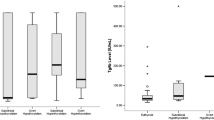Abstract
Neopterin production provides information about the extent of cellular immune activation. Measurement of neopterin levels may also provide predictive and prognostic information in patients with malignant thyroid diseases. In the present study, neopterin levels were investigated in patients with thyroid disorders (no.=68). Twenty-four patients had papillary thyroid cancers and the rest of them benign thyroid disorders. Results were compared with a healthy control group (no.=30). It was observed that there was a significant difference in neopterin levels between the control group and the thyroid disorders group (p<0.05). The mean neopterin levels in malignant and benign patients were also significantly different (p<0.05). Monitoring of urinary neopterin profile may be used in early diagnosis of papillary thyroid cancer. Neopterin seems to be a differential biomarker for malignant and benign thyroid disorders.
Similar content being viewed by others
References
Erdogan G, Erdogan MF, Emral M, et al. Iodine status and prevalence in Turkey before mandatory iodization. J Endocrinol Invest 2002, 25: 224–8.
Hiroshimaya T, Takahashi H, Yao K, et al. Clinical review of thyroid malignant tumor. Acta Otolaryngol Suppl 2002, 547: 85–7.
Carcangiu ML, Zampi G, Pupi A, Castagnoli A, Rosai J. Papillary carcinoma of the thyroid. A clinicopathologic study of 241 cases treated at the University of Florence, Italy. Cancer 1985, 55: 805–28.
Ito Y, Hirokawa M, Jikuzono T, et al. Extranodal tumor extension to adjacent organs predicts a worse cause-specific survival in patients with papillary thyroid carcinoma. World J Surg 2007, 31: 1194–201.
Reibnegger G, Weiss G, Wachter H. Neopterin in malignant diseases. Tumour Marker Update 1992, 4: 101–3.
Altindag ZZ, Sahin G, Kansu E, Duru S. Urinary neopterin levels in patient with leukemia. New J Med Suppl 1995, 12: 29–32.
Yuksel O, Sahin TT, Girgin G, et al. Neopterin, catalase and superoxide dismutase in females with benign and malignant breast tumors. Pteridines 2007, 18: 132–8.
Murr C, Bergant A, Widschwendter M, Heim K, Schröcksnadel H, Fuchs D. Neopterin is an independent prognostic variable in females with breast cancer. Clin Chem 1999, 45: 1998–2004.
Murr C, Widner B, Wirleitner B, Fuchs D. Neopterin as a marker for immune system activation. Curr Drug Metab 2002, 3: 175–87.
Berdowska A, Zwirska-Korczala K. Neopterin measurement in clinical diagnosis. J Clin Pharm Therap 2001, 26: 319–29.
Fukuda A, Mazda T, Gyure WL, et al. A comparative study of urinary xanthopterin and neopterin in liver diseases. Eur J Clin Chem Clin Biochem 1993, 31: 129–34.
Altindag ZZ, Baydar T, Isimer A, Sahin G. Neopterin as a new biomarker for the evaluation of occupational exposure to silica. Int Arch Occup Environ Health 2003, 76: 318–22.
Baydar T, Engin AB, Aydin A, Sahin G. Effect of aluminum exposure on pteridine metabolism. Biol Trace Elem Res 2005, 106: 153–64.
Bjelakovic G, Jevtovic-Stoimenov T, Bjelakovic B, Stojanovic I. Biochemical functions and clinical importance of unconjugated pteridines. Facta Universitatis Med Biol 2004, 11: 49–52.
Huber C, Batchelor JR, Fuchs D, et al. Immune response-associated production of neopterin-Release from macrophages primarily under control of interferon-gamma. J Exp Med 1984, 160: 310–6.
Reibnegger G, Fuchs D, Fuith LC, et al. Neopterin as a marker for activated cell-mediated immunity: application in malignant disease. Cancer Detect Prev 1991, 15: 483–90.
Fuchs D, Weiss G, Reibnegger G, Wachter H. The role of neopterin as a monitor of cellular activation in transplantation, inflammatory, infectious and malignant disease. Crit Rev Clin Chem 1992, 29: 307–41.
Kawasaki H, Watanabe H, Yamada S, Watanabe K, Suyama A. Prognostic significance of urinary neopterin levels in patients with hepatocellular carcinoma. Tohoku J Exp Med 1988, 155: 311–8.
Hoffmann G, Wirleitner B, Fuchs D. Potential role of immune system activation associated production of neopterin derivatives in humans. Inflamm Res 2003, 52: 313–21.
Wagner R, Hayatghebi S, Rosenkranz M, Reinwein D. Increased serum neopterin levels in patients with Graves’ disease. Exp Clin Endocrinol 1993, 101: 249–54.
Schomburg A, Grünwald F, Schultes B, Hotze A, Bender H, Biersack HJ. Are serum neopterin concentrations superior to other parameters in the differential diagnosis and prognostic assessment of Graves’ disease? Exp Clin Endocrinol Diabetes 1996, 104: 123–9.
Author information
Authors and Affiliations
Corresponding author
Rights and permissions
About this article
Cite this article
Sahin, T.T., Yuksel, O., Girgin, G. et al. Is neopterin level a predictive and differential biomarker in patients with thyroid disorders?. J Endocrinol Invest 32, 147–149 (2009). https://doi.org/10.1007/BF03345704
Accepted:
Published:
Issue Date:
DOI: https://doi.org/10.1007/BF03345704




